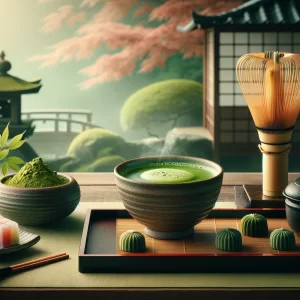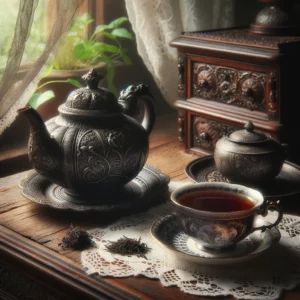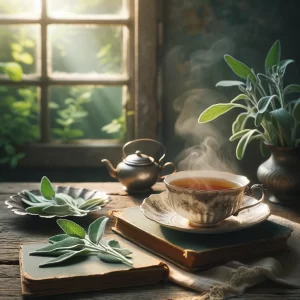Culinary Matcha is a vibrant green powder that has taken the culinary world by storm. Not just for tea anymore, this versatile ingredient brings a unique flavor and color to a wide range of dishes. From lattes to cakes and even savory meals, Matcha adds a touch of elegance and a burst of nutrients to your food. This blog post dives into everything you need to know about Culinary Matcha, including how to choose it, use it, and enjoy its rich, earthy flavor in your cooking. Let’s embark on this green journey and explore how Culinary Matcha can transform your culinary experiences.
Table of Contents
- Introduction
- The Rich History of Matcha Tea
- Culinary Matcha vs. Ceremonial Matcha: Understanding the Difference
- Selecting the Best Culinary Matcha
- The Art of Preparing Culinary Matcha
- Versatile Uses in the Kitchen
- Pairing Matcha with Foods
- Storing Your Culinary Matcha
- Conclusion
- Try Culinary Matcha Tea
1. Introduction
Matcha is a fine, powdered green tea that originated in Japan, famous for its use in tea ceremonies and its health benefits. But there’s more to Matcha than just drinking it. Culinary Matcha is a special grade of Matcha used specifically for cooking and baking. It’s known for its ability to blend well with other ingredients, adding a unique flavor and a beautiful green hue to dishes. As we delve into the world of Culinary Matcha, we’ll discover its origins, how to choose the right type for cooking, and how to incorporate it into your meals to elevate your culinary creations.
2. The Rich History of Matcha Tea
Matcha has a storied history that dates back centuries in Japan. It was first used by Buddhist monks to stay alert and calm during long periods of meditation. Over time, it became a staple in the traditional Japanese tea ceremony, a symbol of hospitality and Zen philosophy. This rich history is not just about the tea itself but also about the culture and traditions that surround its preparation and consumption. Understanding this history enriches our appreciation for Matcha, not just as a culinary ingredient but as a cultural treasure.
3. Culinary Matcha vs. Ceremonial Matcha: Understanding the Difference
When it comes to Matcha, not all types are created equal. Culinary Matcha and Ceremonial Matcha are two main grades, each suited for different uses. Culinary Matcha is designed for cooking and baking, offering a stronger flavor that can stand up to other ingredients. On the other hand, Ceremonial Matcha is all about the tea-drinking experience, with a more delicate taste and texture meant to be enjoyed on its own. Knowing the difference helps you make the best choice for your culinary adventures.
4. Selecting the Best Culinary Matcha
Choosing the right Culinary Matcha is key to successful Matcha-infused dishes. Look for a vibrant green color and a fine, silky texture. These are signs of high-quality Matcha that will deliver the best flavor. Also, consider the origin. Matcha from Japan is often of superior quality, thanks to the country’s optimal growing conditions and expert processing techniques. Don’t forget to check for freshness – Matcha loses its potency over time, so fresher is always better.
5. The Art of Preparing Culinary Matcha
Preparing Culinary Matcha is an art that enhances its flavor and color in your dishes. Start by sifting the powder to remove any lumps, ensuring a smooth texture. When mixing Matcha with liquids, a little goes a long way. Use hot water to dissolve it first before adding it to your recipes. This method preserves Matcha’s vibrant green color and rich flavor, making your dishes visually appealing and delicious.
6. Versatile Uses in the Kitchen
Culinary Matcha is incredibly versatile, suitable for sweet and savory dishes alike. Here are some creative ways to use it in your cooking:
- Drinks: Matcha lattes, smoothies, and cocktails
- Sweets: Cakes, cookies, ice cream, and pastries
- Savory dishes: Noodles, soups, and marinades
Experimenting with Matcha can lead to delightful discoveries and add a unique twist to your favorite recipes.
7. Pairing Matcha with Foods
Matcha’s unique flavor pairs well with a variety of foods. Its slightly bitter and earthy taste complements sweet ingredients like chocolate and fruits, as well as savory ones like seafood and vegetables. Pairing Matcha with complementary flavors can enhance both the taste of the Matcha and the foods it’s paired with, creating a harmonious balance in your dishes.
8. Storing Your Culinary Matcha
Proper storage is crucial to maintaining the freshness and flavor of Culinary Matcha. Keep it in an airtight container away from light, heat, and moisture. This helps preserve its vibrant color and delicate flavors, ensuring that your Matcha is always ready to elevate your cooking to new heights.
9. Conclusion
Culinary Matcha is a gateway to a world of vibrant flavors and creative cooking. Its rich history, versatility in the kitchen, and unique taste make it a must-try for any culinary enthusiast. Whether you’re a seasoned chef or a curious foodie, incorporating Culinary Matcha into your dishes opens up a whole new realm of flavor possibilities. So go ahead, explore the art and flavor of Culinary Matcha, and let it inspire your next culinary creation.
Culinary Matcha is more than just an ingredient; it’s a journey into the heart of Japanese culture and culinary innovation. Embrace it in your kitchen, and let your culinary imagination soar!
Try Culinary Matcha Tea
“As an Amazon Associate I earn from qualifying purchases.”
[azonpress template=”grid” asin=”B00PFDH0IC,B08VZ17H3V,B0DQHVQ7ZW,B01B047566″]



